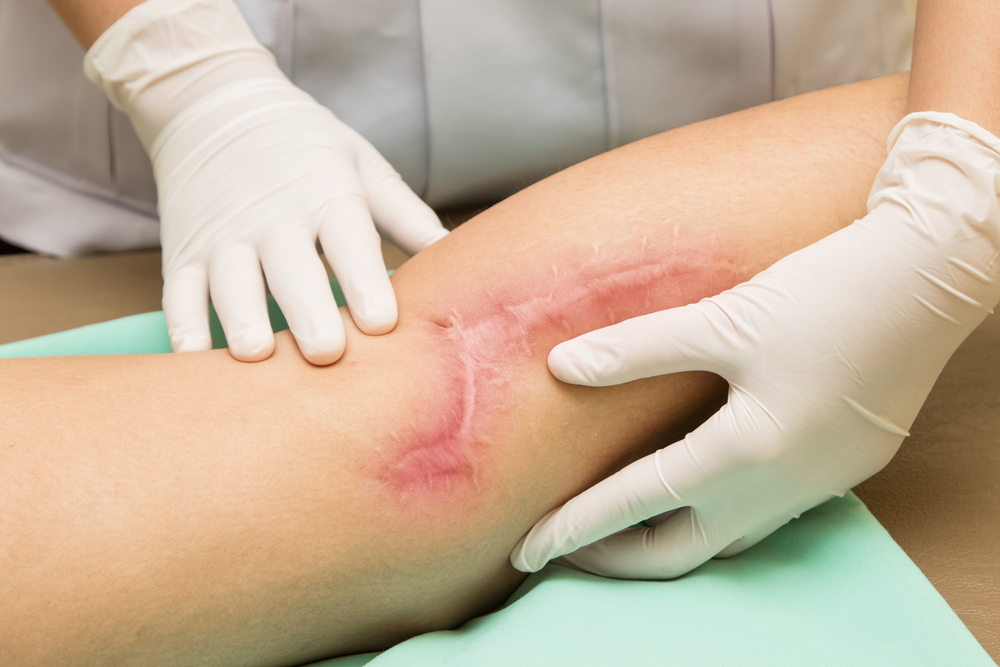An unavoidable consequence of repairing wounds is the formation of scar tissue. Depending on the cause or nature of injury, the quantity of scar tissue generated will vary from one patient to the other. Wound care professionals should seek to minimize scar formation by promoting and providing optimal healing conditions. This article will focus on some essential principles for scar management.
What is Scar Tissue?
Scarring is a normal healing reaction to the presence of tissue injury. When a patient sustains a wound, the body undergoes the various stages of wound repair including re-epithelialization with the formation of granulation tissue. In smaller wounds, tissue repair and resolution are usually comprehensive with minimal scarring. However, serious injuries lead to the formation of dense masses of granulation tissues in the healing phase. These newly formed repair materials are made of recruited fibroblast cells and collagen materials that aggregate to form scar tissue or cicatrix.
Pathology of Scar Tissue Formation
Immediately after an injury occurs, the normal body response is to begin the tissue repair process and resolve the wound. Smaller wounds measuring under 2 mm in thickness will generally heal without scarring within two weeks if no complications arise. However, deeper, more extensive, and slower healing wounds will form varying degrees of scar tissue. The mechanical stress and inflammation resulting from a more severe injury is the basis for scar tissue formation as the extracellular matrix will be triggered to deposit denser repair materials at the wound site.
The pathology of wound scar formation can be summarized as follows:
- Overexpression of non-randomized collagen fibers which are less sturdy than randomized collagen in the original non-wounded tissues.
- Fibroblast consolidation around collagen material results in stiff, less elastic tissues.
- Myofibroblast deposition resulting in further scarring, and healed wound contraction.
- A combination of the above factors will result in the deposition of scar tissue which is significantly less resilient than normal unaffected skin/body tissue.
Categorizing Scars
Scars fall into several categories based on the extent, severity, duration, and appearance or morphology. Scars can be physiological or pathological, such as cicatrices, keloids, hypertrophic scars, and wound contractures.
Complicated Scars
Some of the most common examples of complex scars include keloids, hypertrophic scars, and contractures.
Keloids
These are elevated scar tissues that are the same color as the unaffected skin surrounding the healed wound site. Like other forms of scar tissue, keloids are a result of excessive deposition of collagen and can cause significant pain and deformity. Keloid typically forms unsightly claw-like scars on healed skin of susceptible individuals.
Hypertrophic Scars
Hypertrophic scars usually aggregate on wound sites (cuts, burns, bruises, and body piercings). This category of complicated scars causes elevated, hyperpigmented areas of healed skin tissues that are not as prominent as the ones in patients with keloids. Hypertrophic may contain blood vessels and nerves which make them more prone to repeated trauma and sometimes pain.
Wound Contractures
This is perhaps the most concerning form of complicated wound scarring as it can diminish limb function, and restrict a patient’s ability to carry out normal daily activities. The scars formed in contractures are composed of tight bands of rigid collagen tissue with little or no elasticity. When they occur in normally flexible joints, they hamper free motion around that axis.
Risk Factors
The typical risk factors for developing scars after tissue injury include:
- Age, with older individuals more susceptible to worse scarring
- The presence of infection prolongs the period of wound healing
- Trauma to skin
- Dermatological conditions that weaken the skin barrier
- Genetics
- The presence of chronic medical diseases like hypertension
Scar Treatment Strategies
Regardless of the type of scar a patient gets, there are general principles that guide treatment. Among the routine management options are the following:
- Pressure therapy
- Moisturizers, ointments, gels, and creams
- Polyurethane dressings
- Laser treatments
- Cryosurgery
- Scar excision
- Corticosteroid injections, fluorouracil, and bleomycin
- Radiotherapy
- Vitamin supplements
Pressure therapy
Firmly applied dressing materials can be placed over an injury site and will provide a sustained pressure that will inhibit the formation of keloid and other scar tissues. This treatment strategy can also be used after scar excision to prevent a recurrence.
Moisturizers, Ointments, Gels, and Creams
Moisturizing agents are particularly beneficial in patients at risk of developing wound contractures. In addition to regular exercises for joints, the application of moisturizers can help keep scarred areas flexible. Silicone-based ointments, gels, and sheets are also useful in limiting scar tissue expansion, managing wound site itchiness, and reducing stiffness.
Polyurethane Dressings
Moist dressings made of polyurethane can be used to reduce scar stiffness, itching, and extent.
Laser Treatments
Laser therapy can be used to diminish the likelihood of complex scar formation, as well as diminish associated pain, redness, and itching at the wound site.
Cryosurgery
Targeted application of extremely low temperatures can be used to destroy scar tissue, improve wound scar pigmentation, and minimize pain at the healed site.
Scar excision
Conventional surgical techniques can be employed to remove symptomatic keloids, cicatrices, and other significant scars. To obtain the best results, surgical excision should be combined with pressure dressing to limit scar tissue reformation.
Corticosteroids Injections, 5-Fluorouracil, Bleomycin
Injection of potent corticosteroids like triamcinolone into scar site can be used to inhibit further scarring, and reduce pain or itching. Other chemotherapeutic agents like 5-fluorouracil and bleomycin are also effective in scar tissue management.
Radiotherapy
Targeted radiation therapy has a similar effect on scar tissues as other treatment techniques.
Vitamin supplements
Vitamins E and A have found some use as treatment adjuncts in the management of scarring.



.webp)

.avif)